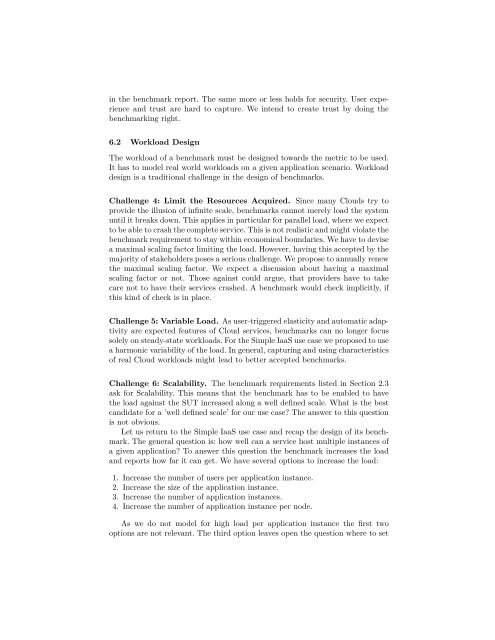Benchmarking in the Cloud - Parallel and Distributed Systems
Benchmarking in the Cloud - Parallel and Distributed Systems
Benchmarking in the Cloud - Parallel and Distributed Systems
Create successful ePaper yourself
Turn your PDF publications into a flip-book with our unique Google optimized e-Paper software.
<strong>in</strong> <strong>the</strong> benchmark report. The same more or less holds for security. User experience<strong>and</strong> trust are hard to capture. We <strong>in</strong>tend to create trust by do<strong>in</strong>g <strong>the</strong>benchmark<strong>in</strong>g right.6.2 Workload DesignThe workload of a benchmark must be designed towards <strong>the</strong> metric to be used.It has to model real world workloads on a given application scenario. Workloaddesign is a traditional challenge <strong>in</strong> <strong>the</strong> design of benchmarks.Challenge 4: Limit <strong>the</strong> Resources Acquired. S<strong>in</strong>ce many <strong>Cloud</strong>s try toprovide <strong>the</strong> illusion of <strong>in</strong>f<strong>in</strong>ite scale, benchmarks cannot merely load <strong>the</strong> systemuntil it breaks down. This applies <strong>in</strong> particular for parallel load, where we expectto be able to crash <strong>the</strong> complete service. This is not realistic <strong>and</strong> might violate <strong>the</strong>benchmark requirement to stay with<strong>in</strong> economical boundaries. We have to devisea maximal scal<strong>in</strong>g factor limit<strong>in</strong>g <strong>the</strong> load. However, hav<strong>in</strong>g this accepted by <strong>the</strong>majority of stakeholders poses a serious challenge. We propose to annually renew<strong>the</strong> maximal scal<strong>in</strong>g factor. We expect a discussion about hav<strong>in</strong>g a maximalscal<strong>in</strong>g factor or not. Those aga<strong>in</strong>st could argue, that providers have to takecare not to have <strong>the</strong>ir services crashed. A benchmark would check implicitly, ifthis k<strong>in</strong>d of check is <strong>in</strong> place.Challenge 5: Variable Load. As user-triggered elasticity <strong>and</strong> automatic adaptivityare expected features of <strong>Cloud</strong> services, benchmarks can no longer focussolely on steady-state workloads. For <strong>the</strong> Simple IaaS use case we proposed to usea harmonic variability of <strong>the</strong> load. In general, captur<strong>in</strong>g <strong>and</strong> us<strong>in</strong>g characteristicsof real <strong>Cloud</strong> workloads might lead to better accepted benchmarks.Challenge 6: Scalability. The benchmark requirements listed <strong>in</strong> Section 2.3ask for Scalability. This means that <strong>the</strong> benchmark has to be enabled to have<strong>the</strong> load aga<strong>in</strong>st <strong>the</strong> SUT <strong>in</strong>creased along a well def<strong>in</strong>ed scale. What is <strong>the</strong> bestc<strong>and</strong>idate for a ’well def<strong>in</strong>ed scale’ for our use case? The answer to this questionis not obvious.Let us return to <strong>the</strong> Simple IaaS use case <strong>and</strong> recap <strong>the</strong> design of its benchmark.The general question is: how well can a service host multiple <strong>in</strong>stances ofa given application? To answer this question <strong>the</strong> benchmark <strong>in</strong>creases <strong>the</strong> load<strong>and</strong> reports how far it can get. We have several options to <strong>in</strong>crease <strong>the</strong> load:1. Increase <strong>the</strong> number of users per application <strong>in</strong>stance.2. Increase <strong>the</strong> size of <strong>the</strong> application <strong>in</strong>stance.3. Increase <strong>the</strong> number of application <strong>in</strong>stances.4. Increase <strong>the</strong> number of application <strong>in</strong>stance per node.As we do not model for high load per application <strong>in</strong>stance <strong>the</strong> first twooptions are not relevant. The third option leaves open <strong>the</strong> question where to set















